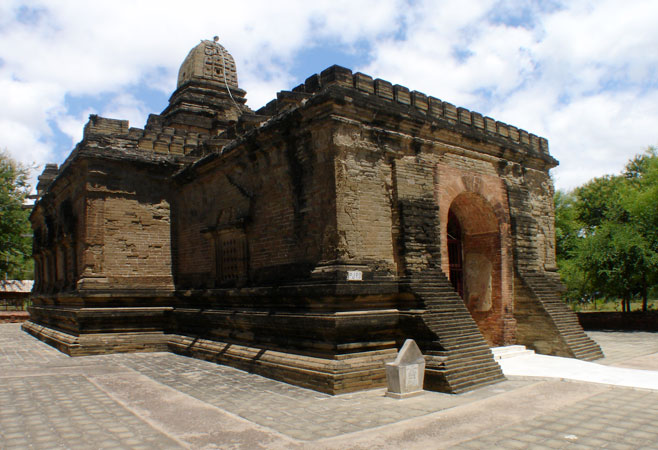Bagan Attractions

East Petleik and West Petleik. These pagodas belonging to 11th century A.D. were in ruins in 1905. When the lower portions were cleared of debris almost entire series of unglazed terracotta plaques depicting scenes from the Jatakas were recovered. The pagodas originally had vaulted corridors round the basements, and the walls were lined with rows of square niches which accommodated the Jataka plaques. These have been placed in position and new roofs were provided to preserve them. The upper portion...

Kyaunggyi Ama Temple and Nyima Temple
Kyaunggyi Ama Temple and Nyima Temple are located in Thiripyitsaya region. Some archeologists assume that Kyaunggyi Ama and Kyaunggyi Nyima temples were built by two sisters of the Bagan Period. Kyaunggyi Ama means “the elder sister of the great temple”. Kyaunggyi Nyima means “the younger sister of the great temple”. Although similar in name, the structure of the temples are different. Kyaunggyi Nyima temple is a Zedi Pauk cave type with no entrance hall. Kyaunggyi Ama Temple is a two-storey...

Bocho Mi Gubyauk Temple is also known as Thiri Gubyauk Temple. The name of this temple was inherited from the name of a hero known as Bocho. As the legend says, Bo Cho and his sons were hiding in this temple during the colonial period before they were caught. (Source:...

Lawkananda Pagoda. Built by Anawrahta in 1059 A.D. It is a stupa with an elongated dome surmounted by a finial of concentric rings in imitation of a series of diminishing umbrellas. The two lower terraces are ascended by flights of steps on four sides though arches are not provided above them. It is one of the typical buildings erected by Anawrahta and is still used as a place of worship, being held in great veneration by the Buddhists of Myanmar...

Thiripyitsayar is a small village that stands at the former site of a Bagan royal palace. It is about 2km south of Myinkaba region. This place also known as New Bagan, since a lot of new dwellings have been constructed. It consists of guest houses, hotels, souvenir shops and many more. (Source:...

Manuha Temple. It was built by Manuha, the captive king of Thaton, in 1059 A.D. It is a reduplicated square structure with a battlemented terrace, the upper storey being smaller than the lower, so that the entire building appears to assume the form of a pyramid. It contains three images of seated Buddhas and a recumbent image of gigantic proportions representing the Buddha in the act of entering Nirvana. The temple is an allegorical representation of the physical discomfort and...

Nagayon Temple. It is an elegant structure belonging to the earlier type attributed to Mon workmanship. The temple has a projecting hall facing north; the external form resembles the Ananda so far as the disposition of the comer stupas, the curvilinear roofs, the terraces, the sikhara and the finial stupa are concerned. The shrine in the centre has a dark corridor running round it, which is ventilated by five perforated windows on each side. Within the hall are niches containing...

Gubyaukgyi is sometimes called “Myinkaba Gubyaukgyi” because of the resembling name of another pagoda in Wet-Kyi In. It is situated just to the left of the road on entering Myinkaba. this temple was built in 1113 by Kyansittha’s son Rajakumar, on his father’s death. In Indian style, the monument consists of a large shrine room attached to a smaller antechamber. The fine stuccowork on its exterior walls is in particularly good condition. The Early period temple is also of particular...

Gubyauknge Temple in Myinkaba was built by King Nadaungmyar during AD 1198. The stone inscription describes the donation of the temple, the land and the slaves. The wall paintings inside the temple remain unruined. (Source:...

Mya Zedi Pagoda is located between Myinkaba and Bagan. Mya Zedi meaning “Jade Pagoda” in Myanmar. From Mya Zedi, two identical pillars were found to have the same inscriptions on each face. Now, one of these pillars are in the Bagan Museum and the other one is under some shelter close to the Mya Zedi. The inscriptions were describing about the Buddhism in Bagan period and also about the feelings of a Prince towards his King father. The pagoda was...

Seinnyet Nyima & Seinnyet Ama Paya
Seinnyet Ama Temple. Said to have been built by Seinnyet Queen in the 11th century A.D., but the design appears to belong to the later Myanmar style of 13 th century. It is a square temple with four entrances through projecting porches, the main one facing west. The superstructure consists of the usual terraces and a sikhara resting on a square basement. It constitutes a duad with the adjoining Seinnyet Nyima. Seinnyet Nyima Pagoda. It is a solid stupa resting...

Nanpaya Temple. Lies close to the Manuha temple. According to tradition, it was used as the residence of the captive Mon king, Manuha. It is built of brick and mud mortar and surfaced with stone, and is square in plan with a porch projecting on the east face. Flanking the sanctuary in the main building are four stone pillars on the sides of each of which are carved triangular floral designs and the figures of the Brahma holding lotus flowers...
Ask a Question?
Feature destinations
WHY MYANMAR TOUR WITH US?
- We are internationally registered, well-recognized
- We respond you within 12 hours
- Local experts, true knowledge
- Our service is personalized, customized at its best
- Easy to pay online
- Best customer care/policy
- Committment to Satisfaction
- Professional Consultancy
- Unrivalled values















